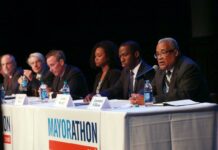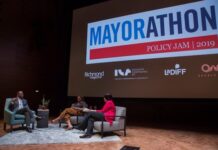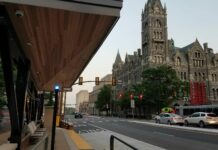Richmond had an eviction crisis before COVID-19 and the pandemic has only exacerbated the problem. To put the looming catastrophe in perspective, consider the following: during July 2020, landlords were awarded an average of $1,787 in each unlawful detainer case. At the time of this writing, there were over 1,200 unlawful detainer cases scheduled to be heard in September. Assuming the average judgment remains roughly the same, this amounts to a total of over $2 million in unpaid rent in September. Not every household facing eviction participates or is eligible for the EDP, nor do they necessarily receive the full 50% of back rent the EDP provides; however, these numbers are illustrative nonetheless. The FY2021 budget allocates $485,000 to the EDP for the entire year. Those funds will be exhausted in roughly two weeks given the current numbers.
Will federal and state programs cover this gap? If not, how will you adequately fund this essential program? What additional solutions do you propose to address the coming wave of evictions?
Due to COVID, the City will likely be facing a long-term decline in revenues, and that means our immediate actions need to focus on the most desperate situations—evictions, homelessness, and restricted health care access. We have not seen where the Mayor is allocating federal CARES Act money because the process has not been transparent. Our Housing Authority is the single biggest evictor in the city; our homeless services operate on 9am-6pm weekday schedule – that must change; and the recently unemployed typically are not prepared for the loss of health care. These are not hugely expensive problems to solve, but they do require knowledge of human service programs and the grit and hard work and patience necessary to solve these problems. I am a 27-year public servant with a background in many of these issues. Unlike our current Mayor, I will do the hard and sustained work to make city and regional organizations first and foremost take care of our most vulnerable populations. Leadership matters and experience matters—ask anyone at Camp Cathy or any resident actually living in our public housing projects.
One of the most rudimentary functions of local government is to provide residents with adequate public facilities. Yet, despite paying the highest property tax rate in the region, flooding is routine on the Southside, in Brookland Park, and across the city. Backyards are falling into eroded and unmaintained alleys in the West End. Where sidewalks do exist, they are often inaccessible to people with mobility challenges. How will you make sure these basic and essential services are fulfilled by City Hall? What will you do differently?
Many drainage issues in various parts of the City have been problems for years but ignored. I will ensure that stormwater fees are dedicated to their intended purpose as part of a five year operating and Capital Improvement Program (CIP). We need to focus on the myriad needs of basic infrastructure, not on big shiny projects like Navy Hill. That includes finding ways to build sidewalks with third parties since a city built sidewalk costs twice as much for the same project in the counties. Having a longer term plan and funding it transparently every year is the only way to address the many needs we have to deliver. It should be a plan of action, not a political one.
What kind of policy would you seek to help maintain Richmond’s economic and racial diversity? Are there existing programs that are underutilized, for example the Real Estate Tax Relief Program, that could be leveraged more effectively? Would you support a longtime owner occupant program similar to Philadelphia’s?
I have proposed the idea of tax deferment so people that have been in their homes for many years will not be forced out by rising assessments, gentrification, or real estate scammers. It would hold in place the tax level of a house until the resident sells and then the tax bill is paid from the proceeds and the house is reassessed. It is similar to a Homestead Exemption and the “LOOP” program in Philadelphia.
Grants, incentives, and tax relief should be provided on objective criteria and not be based on political contributions. We need not only housing policies that build and strengthen real families with a path to home ownership, but also a Mayor that is committed to getting it done instead of relying on press release promises.
Richmond was denser in 1950 than it is today. Increased density cuts housing costs for residents, preserves the City's limited greenspace, and saves the City money on providing essential services. What changes, either administratively or via ordinance, can the City make to help create dense residential development? What steps can Richmond take to entice, encourage, and facilitate additional residential development? How do we ensure a diversity of housing stock that is accessible to Richmonders at all income levels?
The city should expand more housing types throughout the city and allow greater density, especially along major transit corridors and create incentives to convert vacant land into housing opportunities for low-income or first time buyers/renters. I do believe that any incentives should be directed towards “Family Friendly” housing. We need housing policies that build and strengthen real families and meet their real needs.
While the City of Richmond and the Richmond Redevelopment & Housing Authority (RRHA) are subject to federal regulations and budget allocations, there is nothing preventing the full engagement and partnership between these governing bodies and the residents they serve. Unfortunately, the history of public housing in Richmond is a history of distrust, betrayal, and silencing of public housing residents themselves. Like many cities across the nation, Richmond intentionally built highways to segregate and isolate public housing from the rest of the city, effectively preventing its residents from participation in the city's prosperity. Richmond used Urban Renewal to demolish public housing units without a one-to-one unit replacement which resulted in the physical and emotional destruction of public housing neighborhoods. While this is the history of Richmond's public housing, there is nothing that mandates that it also be the future. If elected, how will you work with public housing residents? How will you ensure that residents get to decide their own collective futures rather than having a government entity decide what is best for them?
First, I will reform the RRHA Board by working with Council to appoint an Authority board that welcomes public participation and views RRHA residents as full partners. Second, I will ask the City to review RRHA evictions—they are the single largest source of evictions in the City. Finally, we will achieve a one-for-one relocation of current residents BEFORE we undertake any redevelopment of the major projects. When we condemn properties for highways or sewers, we purchase the properties and relocate tenants. We owe at least this standard of care to the residents of our public housing projects. We also need to conduct any such process mindful of the need to preserve community and family connections.







